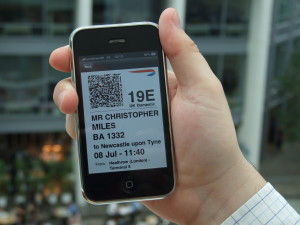October 17th, 2013 by Elma Jane
You find a good deal online, and as you hastily proceed through the checkout, something goes wrong.
After typing in your name, address and credit card number, you mis-key a digit of your credit card number. The transaction doesn’t go through. The screen seems to yell at you. START OVER. You feel like yelling back.
You have to get to a meeting, so you close your browser and vow to revisit the process later or – worse – try booking the flight on another travel site.
Cart abandonment is a well-known problem for merchants trying to sell goods to online shoppers, and it is even more pronounced when the shopper is using a mobile device.
Travelocity was seeing far too much of it, so the online travel booking site turned to Jumio for a solution.
Travelocity’s deployment of Netswipe, Jumio’s credit card scanning and validation tool, provided the basis for discussion in a recent webinar, “How Travelocity Increased Conversion, Engagement on its Mobile Apps,” sponsored by Jumio and hosted by Mobile Payments Today.
The best webinars look at use cases, said Anthony Lanham, Jumio senior vice president for North American sales, and Travelocity’s experience with Netswipe provides a great example.
Travelocity’s problem was straightforward, the online travel agency’s director of engineering. The site is a common destination for people looking for just-in-time bookings, he said. They need it right now.
And with shoppers increasingly accessing the site from mobile devices, there was this pattern. The user doing a last-minute booking is in a hurry. When you’re in a hurry with a small screen, there’s a decent tendency to ‘fat-finger’ and make key-entry errors. The transaction fails, and that becomes frustrating for the user in a hurry.
A Jumio consumer mobile insight study found that a majority of respondents find it too difficult to fill out forms from a mobile device. And if a purchase doesn’t go through, they almost never go back to try again.
They may come back and finish later, but if it’s Travelocity, the door is now open to go to Expedia and book that flight or hotel.”
Netswipe is designed to remove the burden of entering card details. The solution lets users snap a photo of their card with the camera on their mobile device and present it at checkout, removing the need to self-enter.
In the case of Travelocity, when users reach the mobile site’s checkout page, they see an “autoscan with camera” option in the billing header. They hold the card in front of the camera, which scans it and provides the necessary details to the site. The process takes about five seconds.
To test the solution, Travelocity first implemented it on its sister site, LastMinute.com. Adding the software development kit to the LastMinute.com app was simple and early adoption was larger than the company anticipated. That early success led to quick integration of the app on the flagship Travelocity site.
Checkout conversion rates there also increased much more quickly than anticipated. Over two months, customers using the card scan feature converted at 52 percent, compared to 9 percent for other customers. “The data made it clear that ease of entering payment information was the main reason.”
Though Travelocity’s challenge centered on customer conversion and engagement, Netswipe also acts as a fraud deterrent.
Fraudsters always take the path of least resistance and any decent fraudster can get their hands on the name and number and expiration date that match. But once you get to the point of asking that fraudster to put a bona fide card in front of a camera, you are going to instantly cut out a huge swath of fraudsters. For them to take that information and actually translate it on a physical card that would pass muster for the checks that we do is an enormous task. They can go monetize those fraudulent credentials elsewhere easily.
Moharil offered a few lessons from the integration. First, he said, it’s important to measure, and to continue measuring often. For example, are users checking out the feature out of curiosity or are they using it to complete transactions? And it’s important to plan for backward compatibility – making sure earlier versions of the Jumio SDK and Travelocity app don’t have glitches.
Moharil advised rolling out a new solution along the simplest path, in a small use case, early results for Travelocity have been so good, he only wishes the solution were implemented sooner.
The webinar concluded with a short question-and-answer session. The free webinar is now available for Online Replay, and will remain on the Mobile Payments Today site for 12 months.
Posted in Best Practices for Merchants, e-commerce & m-commerce, Travel Agency Agents, Visa MasterCard American Express Tagged with: autoscan with camera, billing, booking, cart, checkout, conversion, credit-card, data, device, digit, fraudster, key-entry, merchant, mis-key, mobile, online, shoppers, site, transaction, travel, travel agency's, travelocity, webinar
September 26th, 2013 by Elma Jane
With revamped iPhone app Travelocity rethinks smartphone bookings
To accommodate for the more gesture-based features in Apple’s new iOS 7, Travelocity rebuilt its iPhone application from the ground up. The online travel agency’s new app is aimed at moving users through the booking process quicker with more visuals. Travelocity has been streamlining all parts of the trip-planning experience with its mobile apps continuously in the past few years.
“Luckily, we have a great, agile team and some top-notch mobile designers, so we were able to dive into the new design as soon as the beta was released. “We also decided early on to rebuild this version from scratch and really work on making it fast and reliable,” said Blake Clark, director of mobile for Travelocity. “We find mobile travelers demand speed and sometimes they’re in less-than stellar connection areas, so that was a big one.”
Streamlined design
Tavelocity updated its iPhone app with a design that highly plays up images and visuals. The app’s home screen shows photos of world cities to inspire consumers to take a last-minute trip. The app also leverages the new AirDrop feature of iOS 7 to let consumers securely share their travel information with friends and family members after they book a hotel.
The new app includes a feature that lets consumers scan their credit cards with a built-in camera feature to cut down on the number of steps that it takes consumers to check out. The technology detects the number on a credit card and automatically fills in portions of the checkout page. The app also highlights Travelocity’s mobile-exclusive offers that take into account a user’s location to serve up relevant offers and deals.
Travel on mobile
Travelocity has been building up its mobile strategy for quite some time with different mobile products and ad campaigns. Most recently, the brand designed its Web site around responsive design, which led to a 6 percent increase in iOS bookings and an 8 percent jump for Android reservations after two month.
Travelocity’s tablet booking experience was also named the best this spring in a study from Mobivity.
Travelocity is the latest example of how iOS 7 has shifted the way that marketers develop mobile apps with more gesture- and touch-based features. “It’s a shift of how Apple customers interact with their devices, and as a leader in the travel space, we wanted to make sure we’re reducing the amount of friction travelers have when booking a trip.” “With the iOS 7 launch, now our app and the device look, work and feel the same; it’s seamless.” Mr. Clark said.
“Travelers can easily access the deep selection and great value Travelocity is known for. Travelocity’s goal – to be a traveler’s trusted companion before, during and after the travel experience.”
Posted in Credit card Processing, e-commerce & m-commerce, Electronic Payments, Mobile Payments, Near Field Communication, Travel Agency Agents Tagged with: agencies, agency, agency's, agent, app, booking, iOS, ios7, Iphone, mobile, smartphone, travel, travelocity

